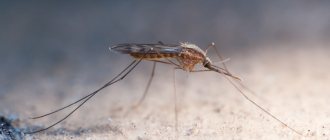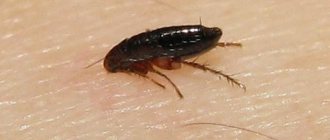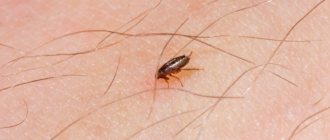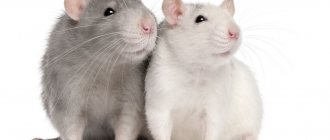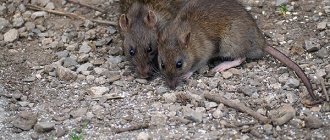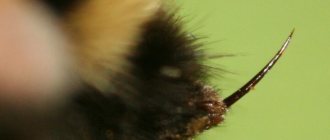Features of human fleas
All fleas are carried by animals, and regardless of what species the pest in question is, the only permanent means of transportation will be pets.
Sand, dog or cat fleas - all pose a certain danger to the person in whose house they can settle, because these small insects will constantly bite both animals and people living in it.
Initially, experts believed that only fleas of the species Pulex irritans, which are the same human fleas, could parasitize humans.
However, in the course of research it turned out that cat fleas, which have completely adapted to modern living conditions, can also annoy people. Naturally, not every pest from a cat will be able to settle on a person, but in practice such cases do occur.
The human flea is a very small, but incredibly nimble insect, reaching only a few millimeters in size. Its body is somewhat flattened and equipped with a small head with a mouth, with the jaws of which it pierces the skin and sucks blood. The antennae serve for orientation, with the help of three pairs of legs it moves, with the hind ones used for jumping in cases of escape from danger.
These fleas are very prolific, and up to five hundred eggs can be laid by a female at a time. After several weeks, small parasites begin to appear in the laying areas, which immediately feel the need for food. The first victim in this case, naturally, will be the nearest pet or person.
Fleas can live on the body of their prey for quite a long time, feeding on its blood twice a day. They move around the body without any special obstacles in search of the most nutritious sources. If danger suddenly arises, insects begin to move very quickly, moving in leaps, in some cases exceeding the length of their body by 50-100 times.
Fleas (order Siphonaptera)
5.2. Fleas (order Siphonaptera)
5.2.1. Features of biology, epidemiological significance
Fleas are small (0.5 - 5.0 mm) wingless insects that parasitize mammals and birds. More than 2000 species of fleas are known, of which more than 500 species are found in our country.
Females and males feed only on the blood of warm-blooded animals and have piercing-sucking type mouthparts. The body of fleas is flattened, covered with a dense elastic cuticle; the paws have well-developed claws, which ensure the attachment and movement of insects in animal fur.
Among fleas collected from rats and other species of rodents (field mice, small wood mice, house mice, voles, and common hamsters), rat fleas Citellophylus fasciatus Bosc., as well as cat fleas Ctenocephalides felis Bouche, dominate in cities. Rat fleas Xenopsylla cheopis Roth are rare in the central and northwestern regions of the European part of Russia. The importation of these fleas with rats into many port cities has been observed.
Fleas are insects with complete metamorphosis and develop through the stages of egg, larvae (3 instars), pupa, and imago. Females lay eggs in waste and dust that accumulate in burrows and nests of animals and birds, sometimes lightly gluing them to the fur of the owner. Fleas living in human homes lay eggs in dust, debris found in floor crevices, behind baseboards, and in animal bedding. Females usually lay eggs in batches of 2 to 13 eggs each. During her life, one female can lay up to 500 eggs.
The timing of flea metamorphosis depends on temperature and air humidity. Under favorable conditions (temperature 18 - 24 °C, humidity more than 60%), egg development ends within 2 - 14 days. The larvae are worm-like, legless and molt twice as they grow. The larvae feed on small particles of the substrate, as well as the feces of adult fleas.
The development time of larvae in different types of fleas ranges from 8 to 18 days; under unfavorable conditions, they can last up to 6 to 8 months.
Under optimal conditions, the development of the flea in the cocoon is completed within 6 - 10 days; in unfavorable conditions - in 1 - 1.5 years. The duration of the entire development cycle of a flea under optimal conditions takes 16 - 49 days, the lifespan of adult fleas ranges from 3 months. up to 1.5 years. Adults emerging from cocoons can immediately begin to suck blood, however, in some cases, they are capable of starving for a long time. Massive flea bites greatly annoy people; scratching can lead to suppuration.
The most dangerous fleas of the genera Xenopsylla and Pulex are carriers of tularemia and plague. A flea becomes infected with plague bacteria (Iersinia pestis) when it sucks blood on a sick animal shortly before its death. The plague microbe multiplies in the flea's digestive canal and forms a block. In rat fleas, a block is formed in 10–45 days; in other species, its formation is delayed up to 2 months. When blood sucks again, the blood cannot pass through the block and returns back to the wound, saturated with plague bacteria. In the body of a flea, plague microbes remain virulent for more than a year. They reproduce and are excreted in feces. Human infection occurs through blood sucking, as well as through contact with the feces of infected fleas. Fleas of rats, house mice, cats, and dogs are carriers of the causative agent of rat typhus (Rickettsia typhi).
In the body of fleas, the bacteria tularemia, pseudotuberculosis, brucellosis, etc. persist for a long time without losing virulence. Fleas of cats and dogs serve as intermediate hosts of helminths: cestodes of dogs and rats.
Spread of fleas in populated areas. The most common habitat for fleas in Russian cities is the basements of buildings of all categories, but more often than apartment buildings (up to 90%). They are also found in residential and office premises, most often located on the first and basement floors; they are much less likely to inhabit attics. Fleas get into basements with synanthropic rodents (rats and mice), stray cats and dogs. From there, insects can independently (at a distance of several meters), on animals or on the feet of people, settle into other rooms of buildings. Fleas are most often brought into apartments by pets, dogs and cats after walking in the yards.
5.2.2. Disinsection measures
5.2.2.1. Preventive measures are aimed at creating conditions under which the appearance of fleas and their reproduction will be reduced to a minimum. Basements must have lockable doors, barred windows and vents to prevent stray animals and homeless people from entering there. Pets (dogs and cats) should be examined after walking and, if fleas are present, treated with insecticides.
5.2.2.2. The hiding places and habitats of all stages of flea development in basements and attics are, as a rule, sand, earth, dust, garbage, and various objects. Therefore, their removal and cleaning of basements help reduce the number of fleas or eliminate them.
5.2.2.3. In residential and office premises, fleas live in crevices of parquet and plank floors, cracks in linoleum, laminate, carpeting, and under baseboards, so frequent wet cleaning of floors leads to a decrease in the viability of flea imagoes. If there are animals in the premises, fleas concentrate in places where they lie and under bedding, sleeping baskets, and upholstered furniture.
5.2.2.4. Particular attention should be paid to the sanitary condition of public places: clinics, schools, kindergartens, clubs, as well as buildings in ports, airports, and railway stations.
5.2.2.5. Extermination activities. Disinsection against fleas is carried out with aqueous emulsions of emulsifiable concentrates or suspensions of wettable powders, microencapsulated preparations, flow, as well as powdered insecticides recommended for treating premises in the dosages and consumption rates specified in the guidelines.
5.2.2.5.1. In basements and attics, floors, objects located on them, walls up to a height of 1 m, and plumbing pipes are subject to treatment, especially if they are wrapped in thermal insulation materials. Particular attention should be paid to the floors in front of the entrances (windows and vents) to these rooms, places where animals lie, and the paths of rodents as places of the highest density of fleas.
5.2.2.5.2. In residential and office premises, floors are treated with insecticidal agents (paying attention to cracks and cracks in them, joints with baseboards), walls up to a height of 1 m, and upholstered furniture (sofas, armchairs). Bedding on which pets sleep must be washed before use.
5.2.2.5.3. To combat fleas, insecticidal preparations based on FOS (chlorophos, karbofos, fenthion), carbamate (propoxur), pyrethroids (permethrin, deltamethrin, cypermethrin, fenvalerate, cyphenothrin, cyfluthrin), neonicotinoids, etc. are used.
5.2.2.5.4. Insect development regulators (AYUG, ISH) can be used to destroy fleas at preimaginal stages. The preparations are used to treat the substrate where insects develop. When exposed to these drugs, the death of insects occurs at each subsequent stage of larval development, and during pupation, a deformed cocoon is formed, and the hatched adults are not viable. The presence of normally formed cocoons indicates a weakening of the effect of the drug. Repeated treatments are carried out when the imago appears, but not earlier than after 1 - 1.5 months. Preparations based on the development regulator diflubenzuron can be considered promising means for killing fleas.
5.2.2.5.5. To instantly kill fleas in small spaces, aerosol products designed to combat flightless insects can be used.
5.2.2.5.6. To destroy fleas in colonies of gerbils, burrows of marmots and pikas, the burrows are sprayed with powdered preparations. The powder consumption rate ranges from 0.5 to 2 kg per colony (burrow). The consumption of the drug is determined by the number of colonies (burrows) per hectare and the method of treatment. Spraying of the drug is carried out using manual and mechanical sprayers. Pyrotechnic means have been developed to destroy ectoparasites (fleas, ticks), for example, insecticidal smoke bombs (briquettes) based on permethrin.
5.2.2.5.7. When assessing the effectiveness of measures to kill fleas indoors, sticky sheets (20 x 30 cm) are used, which are laid out on the floor and under furnishings at the rate of 2 sheets per 10 square meters. cm area. If there are more than 10 fleas on 1 leaf, it is considered that there are “a lot” of fleas; more than 10 are considered “a lot”.
Table of contents
1 area of use
2. Regulatory and methodological documents
3. Conventions
4. Terms and definitions
5. Characteristics of individual orders and the most common species of arthropods in the Russian Federation (main features of biology, ecology, epidemiological significance, control measures, assessment of the effectiveness of measures)
5.1. Lice (order Anoplura, family Pediculidae and Phthiridae). Pediculosis
5.2. Fleas (order Siphonaptera)
5.3. Blood-sucking dipterous insects (mosquitoes, midges, midges, horse flies, mosquitoes)
5.4. Bed bugs (order Hemiptera, family Cimicidae)
5.5. Synanthropic flies (order Diptera, suborder Brachycera Cyclorrhapha - short-whiskered-round-stitched)
5.6. Synanthropic cockroaches (order Blattoptera)
5.7. Ants (order Hymenoptera - hymenoptera, family Formicidae)
5.8. Wasps (order Hymenoptera - hymenoptera, family Vespidae - folded-winged wasps)
5.9. Order Parasitiformes
5.9.1. Ixodid ticks (family Ixodidae)
5.9.2. Argasid mites (family Argasidae)
5.9.3. Rat ticks (family Macronyssidae)
5.10. Order Acariformes
5.10.1. Scabies mites (family Sarcoptidae)
5.10.2. House dust mites (family Pyroglyphidae)
5.10.3. Red mites (family Trombiculidae)
6. Disinsection measures
6.1. Preventive actions
6.2. Extermination activities
6.3. Individual protection of people from attacks by blood-sucking insects and ticks
7. Resistance of arthropods to insecticides (criteria that determine the tactics of disinfestation work)
8. Organizing, planning and carrying out pest control activities
9. Disinsection measures in objects of various categories
9.1. Institutions, organizations, enterprises and facilities where preventive and exterminatory measures should be carried out
9.2. Disinsection activities carried out in open areas
9.3. Rules of behavior for people when staying in an area dangerous with regard to tick-borne encephalitis and other infections caused by ixodid ticks
9.4. Disinsection measures in foci of vector-borne infections
10. Safety measures during disinfestation
11. First aid measures for insecticide poisoning
12. Criteria for assessing the safe use of pest control agents
13. Equipment used when carrying out pest control work
Annex 1
Appendix 2
Appendix 3
Appendix 4
Appendix 5
Appendix 6
Appendix 7
Appendix 8
Appendix 9
Appendix 10
Appendix 11
Appendix 12
back to contents
What is the danger of fleas to humans?
Fleas, having been transmitted to humans from an animal, adapt for quite a long time to existing on a new food source. However, after this they begin to lead a very active lifestyle. By biting a person, they feed on his blood.
A person, depending on individual susceptibility, experiences a burning sensation or pain at the site of the bite, and sometimes an allergy occurs.
What’s much worse is that the pest can serve as a carrier of a dangerous disease. This list is headed by listeriosis, tularemia, dipylidia, rat typhus, pseudotuberculosis and even plague.
The danger of flea bites in humans manifests itself both in complex diseases and standard symptoms (tumors, itching). In addition to ulcers and severe scratching, such an infection can provoke increased nervousness, sleep disturbances, etc.
For children who have been bitten by fleas, the danger increases, since it is more difficult for them to curb the desire to scratch the painful area, rather than introducing another infection.
Moreover, if a person has become a “donor” for sand fleas, then the latter can not only infect his skin with an infection, thereby leading to the formation of serious purulent wounds at the sites of ordinary bites, but also settle inside them and spread under the skin.
Fleas and children
Considering the question of why flea bites are dangerous for a child, we note that in young children the immune system is not fully formed and is not fully able to repel parasite attacks. That is why the child’s body reacts so sharply to any outside interference.
As a result of flea activity, children develop severe allergic reactions, accompanied by weakness, loss of appetite, fever, and in severe cases there is a risk of anaphylactic shock.
Flea
Important! At the first signs of infection in a child, you should consult a specialist. Only he can prescribe medications that are effective in each individual case. You cannot self-medicate.
The best option is to send the children to relatives or friends, and carry out a thorough disinfestation of the apartment. Otherwise, the child’s weakened body will attract a variety of diseases like a magnet.
What do bites look like?
If cat or dog fleas have bitten a person, the bite marks on the surface of the skin will appear very quickly. This kind of inflammation manifests itself with pronounced symptoms, the first of which can be noticed even at the moment the parasite penetrates the skin. At this moment, a person feels a prick and a strong burning sensation, after which a specific, somewhat painful itching occurs.
Interestingly, fleas, unlike, for example, bedbugs or mosquitoes, do not try to hide their presence by injecting an anesthetic enzyme into the bite site. On the contrary, in order for the blood to flow more abundantly, the flea distributes a special enzyme around the puncture that provokes bleeding.
The visual symptom of a bite on a person’s body is a red spot with swelling and a pinpoint wound in the center. Often the swelling goes away quickly, but the spot can “decorate” the body for several more days. In addition, it can increase in diameter, which signals an allergic reaction of the body to the parasite bite.
The effect of flea bites on children
A child under 10 years of age reacts to flea bites much more sharply. Children have thinner skin and the bite is deeper and more painful. Allergic reactions occur more often: the temperature rises, the skin around the wound becomes very swollen and painful. Small children cannot resist scratching the bite site vigorously, damaging the inflamed skin.
Children who have not yet been vaccinated have weak immunity. Their body is not equipped to produce antibodies, and any disease carried by fleas is much more severe.
How to fight parasites
If fleas move around the human body, bite and leave unpleasant marks, they definitely need to be dealt with. What to do in this case?
Treatment of wounds
Before you start removing parasites, you need to know how to properly treat a bite wound so that the infection does not spread:
- Immediately treat the bite site with some antiseptic. The latter can be an alcohol- or water-based disinfectant, a special lotion or regular soap.
- Apply a cold compress, such as a piece of ice, to the wound.
- After exposure to cold, apply a product that relieves itching and pain. It could be an ointment for insect bites.
Ridding the house of fleas
It is possible to completely remove these pests only through a whole complex of actions, which are quite labor-intensive and time-consuming.
It will be necessary to thoroughly “etch” the entire house with insecticides. It is important to note here that it is the entire house, including the balcony, bathroom, toilet, and so on. You will also have to look under baseboards and carpets, into a vacuum cleaner, into a ventilation shaft and other equipment. Treat bed linen and upholstered furniture.
In addition to using medications for fleas on people, it will be necessary to purchase special medications for fleas on pets (if you have them).
If you once managed to rid your home of pests, do not forget to constantly carry out preventive treatments at least once a month in order to completely eliminate the possibility of repeated “infestation”.
Treatment and prevention of fleas
Flea treatment should be carried out as needed. The following tools are suitable for this:
- drops on the withers;
- flea collar. Most effective after standard drop treatment. They do not put it on immediately, but the next day;
- shampoo. Ineffective. It works great when applied, but then its protective layer is washed off, and animals are left without protection from parasites.
With severe flea infestation, owners may notice a complete lack of effect of all of the above remedies. This is due to the fact that parasites live not only on the animal, but also indoors, on beds and in the floor. Therefore, in these cases, the entire apartment along with the pet is treated with special means. Drugs for four-legged animals are selected that can influence the life cycle of the flea and its reproduction (for example, Frontline).
The most important rule that should not be forgotten is simultaneous deworming and getting rid of fleas. This is due to the fact that fleas are carriers of certain types of intestinal parasites.
Follow these recommendations and consult your veterinarian if necessary. Health to your pets!
Measures to prevent bites
Measures to prevent flea bites To avoid troubles and health problems, it is necessary to take timely measures to destroy dangerous parasites.
- Pets should be treated with special flea medications between April and October. For these purposes, sprays, drops, collars, injection solutions, shampoos, tablets are produced, and folk remedies are used, the safest and most effective of which is tar soap. Products for treating dogs are different from products for removing fleas from cats.
- The apartment is treated for preventive purposes if there are animals in the house. To repel fleas, substances with a pungent odor are used - essential oils of plants, vinegar, ammonia. If the apartment is infected, it should be treated with insecticidal preparations. To get rid of fleas, use aerosols, sprays, concentrated solutions - Raptor, Butox, Deltsid.
Fleas at home
Most fleas have a clear “career orientation.” Thus, rat fleas prefer the blood of rats, dog fleas prefer the blood of dogs, etc. But due to various circumstances, they are able to feed on any other animals, including humans.
If the animal is in the house, its fleas will settle nearby. They live in pet bedding, in floor crevices, behind baseboards or under furniture. By biting a person, fleas transmit various diseases to him, causing, at a minimum, irritation, at a maximum – death.
How to protect yourself
Knowing what diseases fleas carry, you want to avoid encounters with them by any means necessary. In order to do this, you should pay more attention to the health of pets and birds. For preventative purposes, purchase anti-flea collars for dogs and cats for your pets and treat the house. The best means for this purpose are:
- Raid;
- Raptor;
- Dichlorvos;
- Clean house;
- Butox 50.
Carry out wet cleaning regularly to prevent dust accumulation and rodents. Everything must be done to ensure that parasites, even if they appear in the house, do not want to stay there.
Dangerous diseases
Fleas on cats are dangerous because they can spread deadly diseases. In the last century, it was these insects, parasitizing rats, that became the spreaders of the plague.
You can potentially become infected from small parasites and their bites:
- encephalitis;
- tularemia;
- anthrax;
- bubonic plague;
- typhus;
- trypanosomiasis.
The likelihood of infection is reduced to a minimum. A person quickly forgets about the unpleasant incident with a flea attack and continues to live his life. However, the incubation period of some diseases lasts up to 2 months. Common signs of any dangerous disease are fever, intoxication, and weakness.
In such cases, you need to seek help from specialists. A dangerous disease diagnosed in its early stages responds well to treatment.
Interesting!
In exotic countries, the most dangerous are sand fleas, which get under the nail and live under the skin for several months. The female lays eggs in the body, and as the larvae grow, swelling increases on the surface of the skin. If there is a severe infestation of sand fleas, a person may lose motor ability.

